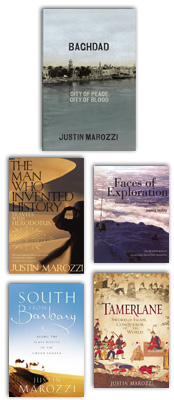So, you thought the Grand Tour was an 18th-century phenomenon? The preserve of languid young aristocrats milording it through Europe, swanning across Paris and Geneva, cutting a dash in Turin, Florence, Rome and Venice, before hightailing it to Innsbruck, Heidelberg and Potsdam? Think again.
The Greeks were at it well before that. Two millennia, in fact. And you’d struggle to find a better, more dashing Grand Tourer than Herodotus, the fifth-century father of history, whose gallivanting expeditions across North Africa, the Aegean and the Middle East form the perfect itinerary for the traveller of today. He did it over the course of a lifetime, admittedly, but it’s perfectly possible to squeeze the highlights into two or three weeks. Much as we’d love to visit Babylon, we’ll leave Iraq to one side for now and concentrate on Turkey, Egypt and Greece.
Let’s begin in the resort town of Bodrum, Herodotus’s home town of Halicarnassus on Turkey’s Aegean coast. There’s little left of the Mausoleum, one of the Seven Wonders of the ancient world, but the 16th-century Castle of St Peter is magnificent and the sailing in island-studded turquoise seas is superb. History buffs can immerse themselves in the faded glory of Ephesus, Priene and Pergamum, leaving the dedicated clubbers to enjoy Halikarnas, which describes itself as the most beautiful disco in the world.
From the ruins of Turkey, it’s off to Egypt, which completely mesmerised our Greek traveller. As he wrote in The Histories, his one-volume masterpiece, “more monuments which beggar description are to be found there than anywhere else in the world”. No surprise to find the sky-grazing pyramids on the itinerary. No Egyptian monument is quite as magical, especially at dawn and dusk, when the crowds have disappeared. Guides told Herodotus no end of nonsense about the pyramids. Someone told him that the pharaoh Cheops, running out of money while he was building the Great Pyramid, decided to send his daughter to a brothel, where she charged her customers one block of stone – think 2.5 tons of limestone – per romp.
Next we take to the Nile to visit many-templed Luxor, the Thebes of old, where monumental overload is a distinct possibility. Apart from the sublime Temple of Hatshepsut, my own favourite, a stone’s throw from the rather impersonal royal tombs in the Valley of the Kings, are the deliciously informal – and much less visited – Tombs of the Nobles, a riot of colour, everyday life and romance. Then we’re off again further south to Aswan – a spot of luxury at the Old Cataract Hotel never hurt anyone – and Kom Ombo where the ancient Egyptians once worshipped the snout-faced crocodile-god Sobek.
When you’ve had enough of the Nile, the Sahara beckons, and there are few more evocative spots amid its sandy wastes than the oasis of Siwa, which Herodotus visited a century before Alexander the Great arrived in February 331BC to consult the famous oracle of Ammon. Standing in Alexander’s footsteps in the crumbling ruins of the temple is an unforgettable experience not to be missed. To the north, the sun-singed escarpment of limestone, folded in shadow; to the east, the flashing jewel of Lake Aghurmi; Jebel al-Mawta, mountain of the dead, to the west and, beyond it, the incomprehensibly vast mirror of Lake Siwa; to the south, the snub-nosed mountain Jebel Dakrur, the whole panorama overwhelmed by a floating sea of feathery palms that melt eventually into the crashing ocean of dunes, wave upon glittering wave, of the Great Sand Sea.
Where else but Greece should our Herodotean odyssey end. In Athens we must make the obligatory pilgrimage to the Parthenon, beacon of democracy and pinnacle of Greek classical art. Impossible to miss the Archaeological Museum, even if museums aren’t your thing. This is one of the world’s greatest. We leave the city on a day trip to the sacred site of Delphi, scattered across terraces beneath twin fangs of rock and the lower slopes of Mount Parnassus. The setting of the Pleistos Valley, studded with olive trees and cypresses, is preternaturally beautiful – precisely why the Greeks chose it as a place in which to honour Apollo and Dionysus and consult the Oracle.
Then, with a final flourish, it’s off the beaten track to Samos, a wonderful, whale-shaped island perched off Turkey’s Aegean coast. Herodotus was wowed by three spectacular monuments on the island, and if the Temple of Hera and the Polycrates harbour breakwater don’t do it for you, you’ll still be captivated by the most exciting of the trio, the sixth-century BC Eupalinos Tunnel that slices through Mount Kastro with aplomb. Failing that, tuck into large quantities of the sweet Samian wine that Byron, among others, recommended.
By now, you’re probably reeling from all these tumbledown tombs and temples. You’ve had your fill of sylvan groves and scattered columns and pyramids, and you just want to kick back with a sundowner. So, without further ado, we sail overnight from Samos to Thessaloniki and hotfoot it to Kavala to stay in the incomparable Imaret, which is as much monument as unspeakably magnificent hotel – an award-winning conversion of a 19th-century school, baths, prayer hall and soup kitchen.
Enjoy the luxury. Herodotus would have approved.

